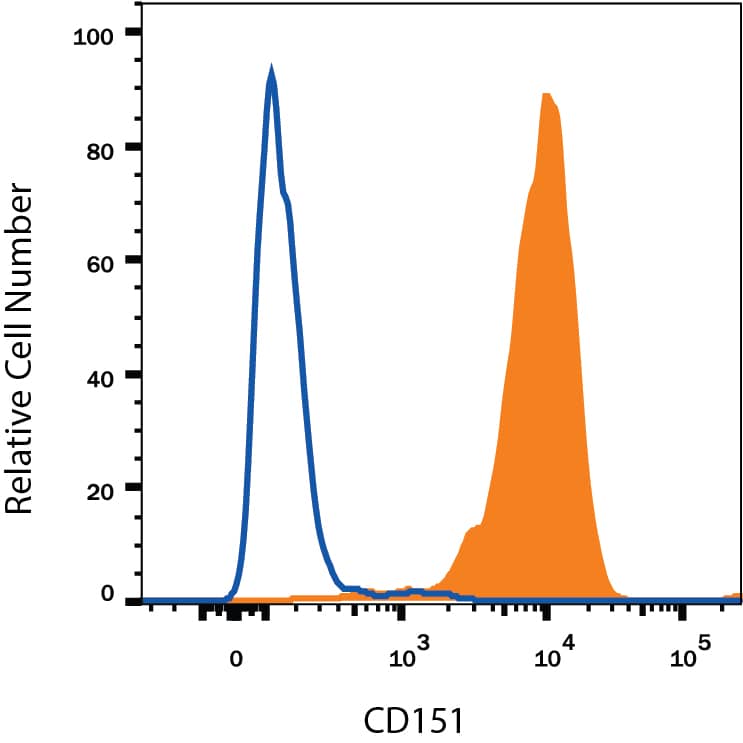Mouse CD151 Antibody
R&D Systems, part of Bio-Techne | Catalog # MAB4609


Conjugate
Catalog #
Key Product Details
Species Reactivity
Mouse
Applications
CyTOF-ready, Flow Cytometry, Immunocytochemistry
Label
Unconjugated
Antibody Source
Monoclonal Rat IgG2A Clone # 455807
Product Specifications
Immunogen
HEK293 human embryonic kidney cell line transfected with mouse CD151
Met1-Tyr253
Accession # BAA22447
Met1-Tyr253
Accession # BAA22447
Specificity
Detects mouse CD151. Stains mouse CD151 transfectants but not irrelevant transfectants.
Clonality
Monoclonal
Host
Rat
Isotype
IgG2A
Scientific Data Images for Mouse CD151 Antibody
Detection of CD151 in bEnd.3 Mouse Cell Line by Flow Cytometry.
bEnd.3 mouse endothelioma cell line was stained with Rat Anti-Mouse CD151 Monoclonal Antibody (Catalog # MAB4609, filled histogram) or isotype control antibody (Catalog # MAB006, open histogram), followed by Phycoerythrin-conjugated Anti-Rat IgG F(ab')2Secondary Antibody (Catalog # F0105B).CD151 in bEnd.3 Mouse Cell Line.
CD151 was detected in immersion fixed bEnd.3 mouse endothelioma cell line using Rat Anti-Mouse CD151 Monoclonal Antibody (Catalog # MAB4609) at 10 µg/mL for 3 hours at room temperature. Cells were stained using the NorthernLights™ 557-conjugated Anti-Mouse IgG Secondary Antibody (red; Catalog # NL007) and counterstained with DAPI (blue). Specific staining was localized to cytoplasm. View our protocol for Fluorescent ICC Staining of Cells on Coverslips.Applications for Mouse CD151 Antibody
Application
Recommended Usage
CyTOF-ready
Ready to be labeled using established conjugation methods. No BSA or other carrier proteins that could interfere with conjugation.
Flow Cytometry
0.25 µg/106 cells
Sample: bEnd.3 mouse endothelioma cell line
Sample: bEnd.3 mouse endothelioma cell line
Immunocytochemistry
8-25 µg/mL
Sample: Immersion fixed bEND.3 mouse endothelioma cell line
Sample: Immersion fixed bEND.3 mouse endothelioma cell line
Formulation, Preparation, and Storage
Purification
Protein A or G purified from hybridoma culture supernatant
Reconstitution
Reconstitute at 0.5 mg/mL in sterile PBS. For liquid material, refer to CoA for concentration.
Formulation
Lyophilized from a 0.2 μm filtered solution in PBS with Trehalose. *Small pack size (SP) is supplied either lyophilized or as a 0.2 µm filtered solution in PBS.
Shipping
Lyophilized product is shipped at ambient temperature. Liquid small pack size (-SP) is shipped with polar packs. Upon receipt, store immediately at the temperature recommended below.
Stability & Storage
Use a manual defrost freezer and avoid repeated freeze-thaw cycles.
- 12 months from date of receipt, -20 to -70 °C as supplied.
- 1 month, 2 to 8 °C under sterile conditions after reconstitution.
- 6 months, -20 to -70 °C under sterile conditions after reconstitution.
Background: CD151
Alternate Names
CD151, PETA-3, SFA-1, TSPAN24
Gene Symbol
CD151
UniProt
Additional CD151 Products
Product Documents for Mouse CD151 Antibody
Product Specific Notices for Mouse CD151 Antibody
For research use only
